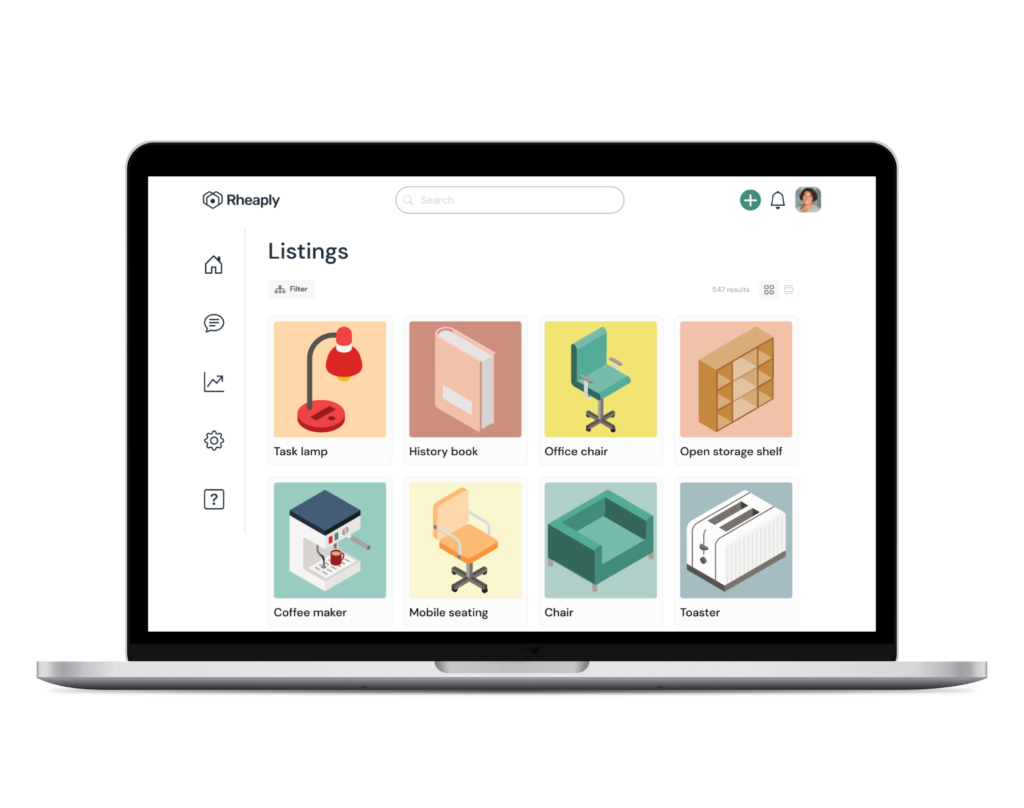In the world of business, the acronym FF&E stands for Furniture, Fixtures, and Equipment. These assets play a crucial role in the operations of various industries, including hospitality, healthcare, and corporate sectors – really, every workplace setting. Imagine an office building. If you take that building, turn it upside down, and give it a good shake, everything that falls out is the FF&E.
But what happens to these assets when they are no longer needed or become idle?
At Rheaply, we’re on a mission to build a connected community where every resource finds its next use.
You’ve heard the phrase one person’s trash is another’s treasure? So much of the stuff a business has sitting around is actually still super valuable. When we reuse things, whether internally or by sharing with others, we extend the value. Scaling reuse to tackle carbon emissions is the goal of the circular economy, a space we’re extremely familiar with.
Let’s explore what FF&E is and how companies can embrace sustainable practices with the help of Rheaply, a platform dedicated to fostering reuse and circularity.

Understanding FF&E
FF&E, or Furniture, Fixtures, and Equipment, encompasses a wide range of assets that are essential for business operations.
- Furniture includes items such as desks, chairs, cabinets, and tables.
- Fixtures refer to items like lighting appliances, plumbing installations, and other fixed equipment.
- Equipment refers to machinery, appliances, and tools required for specific tasks and functions – think servers, computers, monitors, keyboards, and the wide variety of industry-specific equipment that businesses require.
In traditional business practices, when a company no longer needs certain FF&E assets, they are often disposed of, leading to huge waste generation and negative environmental impact. However, the circular economy offers an alternative solution by promoting the reuse of these assets, reducing waste, and maximizing their lifespan.
Rheaply is a company of people who champion the circular economy, providing businesses, governments and nonprofits with the tools they need to embrace reuse and create a more sustainable future. Our innovative platform connects businesses with a vast network of often-local organizations, allowing them to easily exchange, redistribute, and reuse FF&E assets.
It’s estimated that 8.5 million tons of FF&E goes to the landfill each year. That number has risen quickly following the shift to remote work and ongoing economic uncertainty. Major enterprise businesses have been decommissioning office spaces to recover real estate investments, and many of them choose to throw it all away. We know that for many of these organizations, sending items to the landfill is the easiest or cheapest way to get things gone. As we well know, there is another way.
Through reuse, this number can be drastically lowered. It’s about more than lowering metrics though, let’s explore the other upsides.
Benefits of FF&E reuse:
1. Cost savings: Reusing FF&E assets can significantly reduce a company’s expenses. Rather than purchasing new items, businesses can find cheaper suitable assets through Rheaply’s marketplace at a fraction of the cost, saving money that can be invested in other areas of the business.
2. Recover revenue: Selling your lightly used FF&E instead of throwing it away makes good business sense. These assets have plenty of value that you can reclaim for your budget.
3. Environmental impact: By reusing FF&E assets, businesses can minimize waste generation and reduce the demand for new production. This helps to conserve natural resources and reduce carbon emissions associated with manufacturing processes.
4. Community engagement: Rheaply fosters collaboration among businesses, government, nonprofits, and community organizations. By participating in this circular network, companies can contribute to the local community, donating unused assets to organizations that can benefit from them.
FF&E reuse examples
Rheaply has already made a significant impact on reducing the waste and various organizations. For instance, Rush University Medical Center diverted 53,000 pounds of furniture waste through Rheaply, making their decommissioning efforts more sustainable.
There’s also the story of how our team saved 1,600 office chairs ($96,960 in value for the curious) from the landfill and into the hands of remanufacturers and nonprofit organizations. We are also scaling FF&E reuse in city marketplaces across the country.
These FF&E assets are integral to business operations, but their lifecycle doesn’t have to end with disposal. Through platforms like Rheaply, companies can embrace reuse and the circular economy, saving costs, reducing waste, and positively impacting the environment. By making a shift in how they think about their operations, businesses can contribute to a more sustainable future while also gaining access to affordable and quality FF&E assets.
So, next time you think of getting rid of your FF&E assets, consider the benefits of reuse and the circular economy with Rheaply. Together, we can build a more sustainable and resourceful world.

